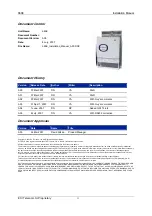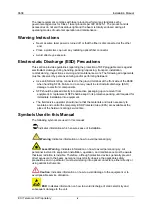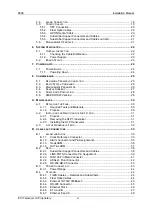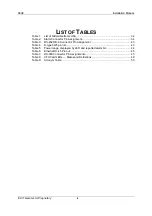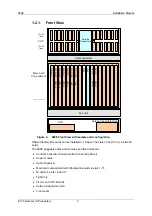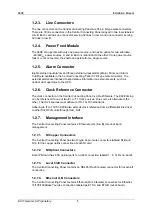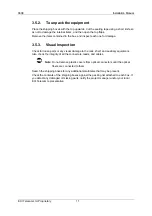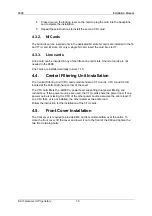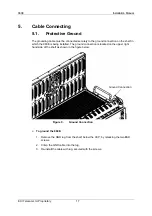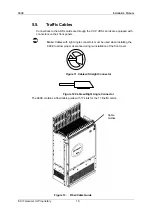
960E
Installation Manual
ECI Telecom Ltd. Proprietary
5
1.2.3. Line
Connectors
The line connectors on the Central Connecting Panel are 78 pin D-type male connectors.
There are 30 line connectors in the Central Connecting Panel arrayed in two rows labeled
A & B. Each card has one connector serving 32 lines in row A and one connector serving
32 lines in row B.
1.2.4.
Power Feed Module
The 960E can operate with only one power source, and has an option for two alternate
–48/60V
DC
power sources, A and B. Each is redundant to the other. If one power source
fails or is not connected, the shelf can operate from a single source.
1.2.5. Alarm
Connector
Eight external input alarms and three external output alarms (Major, Minor and Alarm
Cutoff) are available in the Central Connecting Panel 37 D-Type male connector. The
external alarms are intended to send status information on external events, such as
cabinet door openings, to the OPS.
1.2.6. Clock
Reference
Connector
The clock connector on the Central Connecting Panel is a RJ-45 female. The 960E timing
can be referenced to one of two E1 or T1 clock sources. One source is alternate to the
other. The clock sources must adhere to ITU-T G.703 standards.
Adhering to ITU-T G703, 960E also extends clock reference from a differential line driver
to other Hi-FOCuS units through CLK_OUT.
1.2.7. Management
Interface
The Central Connecting Panel contains 2 Ethernet ports (A & B) for out-of-band
management.
1.2.7.1. NI
Copper
Connectors
The Central Connecting Panel has two D-type 44 pin male connectors labeled NI B and
NI A for the copper uplink connection of each NI card.
1.2.7.2. NI
Optical
Connectors
Each IPNI card has 8 SC optical ports for uplink connection labeled 1…8 Tx Rx (in-band).
1.2.7.3.
Local Craft Connector
The Central Connecting Panel contains an RS485 (RJ-45 female) connector for local craft
connection.
1.2.7.4.
Ethernet A, B Connectors
The Central Connecting Panel contains Ethernet (RJ-45 female) connectors for Ethernet
10/100/1000BaseT service connection labeled as ETH A and ETH B (out-of-band).


